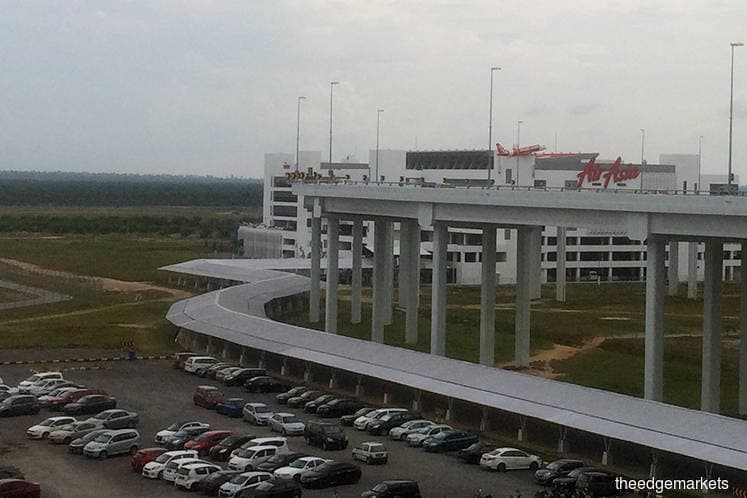
This article first appeared in The Edge Malaysia Weekly on November 27, 2017 - December 3, 2017
COMPETITION is seen abating in Malaysian skies as low-cost carrier (LCC) AirAsia looks set to end 2017 with an even bigger slice of the domestic market. Asia’s largest LCC group by passenger volume, the airline has surpassed the 50% market share mark for the year so far domestically as rivals Malaysia Airlines and Malindo Air cut back on domestic capacity.
The last time AirAsia achieved this was before Malindo Air’s entry into the local market in early 2013. For the nine-month period to Sept 30 (9M2017), its domestic market share stood at 51% compared with 46% for the whole of 2016.
In comparison, Malaysia Airlines saw its domestic market share decline from 42% in 2016 to 34% in 9M2017 — inclusive of its point-to-point carrier subsidiary Firefly’s market share — while Lion Group’s Malindo Air increased its domestic market share by three percentage points over the same period to 15% year to date.
On a quarterly basis, AirAsia has stayed above the 50% threshold for two consecutive quarters, according to data from the International Air Transport Association (IATA).
“AirAsia has benefitted from Malaysia Airlines’ and Firefly’s capacity reductions and gained market share as a result this year,” says Corrine Png, CEO of Crucial Perspective, a boutique research firm focusing on Asian transport equities.
“This is significant because not only did AirAsia manage to gain market share on domestic routes, the carrier also managed to improve its average fare and revenue per average seat kilometre (RASK) in the second quarter of 2017 (2Q2017),” she tells The Edge.
In the quarter ended June 30, 2017 (2QFY2017), AirAsia reported an 11% increase y-o-y in RASK to 15.35 sen following a 3% increase y-o-y in 1QFY2017. Its average fare in 2QFY2017 was RM177, up 10% y-o-y. AirAsia is expected to release its 3QFY2017 financial results this week.
Meanwhile, Malaysia Airlines is cutting domestic capacity by a fifth this year, then-CEO Peter Bellew said in August as it looks to steer clear of a fare war that has gripped the domestic sector in recent years.
In late July, the airline said it is returning six narrow-body Boeing 737-800 to lessors over the second half of 2017. The planes are being removed from domestic routes, including flights between Kuala Lumpur, Kuching and Kota Kinabalu due to low yields, it said at the Invest Malaysia 2017 conference.
Meanwhile, in early April, Malindo Air cut its domestic capacity to Kota Kinabalu and Kuching and also terminated flights to Miri, reports say. The reduction accounted for 13% of its domestic capacity from KLIA and Subang airport, according to CIMB Research.
In 2018, Png expects the domestic market share split to remain at 51% for AirAsia, 34% for Malaysia Airlines and Firefly collectively, and 15% for Malindo Air.
“This is already a comfortable lead. As the year progresses, we expect AirAsia’s domestic market dominance to grow while Malaysia Airlines and Malindo’s market shares are likely to drop,” she tells The Edge.
Capacity expansion
While easing competition may translate to higher fares for domestic flyers, the full impact on air passengers’ wallets may be more gradual, says Png.
“Going forward, with Malaysia Airlines and even Malindo Air scaling back their capacity on domestic routes, this should ease the competitive pressure for AirAsia,” says Png. “However, AirAsia’s pricing power may not necessarily increase much because the carrier plans to grow capacity on domestic routes more aggressively next year compared to this year.”
This year, AirAsia is expected to grow available seat kilometres (ASK) by an average of 10%, according to MIDF Research in June, as the group is scheduled for a net addition of 27 new aircrafts.
AirAsia has told investors that it is expecting to take delivery of 28 new aircraft in 2018. As at end-2016, its group-wide fleet had 174 planes. Its website says its Malaysian operations currently has 81 planes.
The LCC does not give guidance to investors on market-specific capacity expansion forecasts. But while the deployment of the new planes is not yet certain, analysts The Edge spoke to expect domestic capacity in Malaysia to see strong growth next year.
“I expect AirAsia’s domestic capacity in Malaysia to grow by a low double-digit percentage next year,” says one research analyst who declines to be named.
AirAsia’s expansion is supporting domestic passenger volume growth as its peers scale back locally.
One gauge of that is the domestic passenger volume growth at the KLIA main terminal building (MTB), where Malaysia Airlines and Malindo Air are based. Malindo Air used to operate out of klia2 but shifted in March 2016 as it rebranded as a full-service carrier.
In 2016, KLIA MTB saw domestic volume grow 30.4% y-o-y, partly thanks to the transfer of Malindo Air and its parent Lion Air from klia2 to KLIA. As a result, klia2 saw domestic volume decline by 2.8% y-o-y.
Between January and October 2017, KLIA MTB saw domestic passenger volume shrink by 0.1% y-o-y while klia2 saw a corresponding growth of 11.1% y-o-y, according to the latest data released by Malaysia Airports Holdings Bhd (MAHB) on Nov 10.
“Domestic passenger growth was essentially contributed by AirAsia,” MAHB stated in its Nov 10 statement.
In a Sept 25 note, CIMB Research expects Malaysia Airlines and Malindo Air to reduce their collective domestic capacity from KLIA MTB by 23% by end-2017, and AirAsia to grow its klia2 capacity by 11.7%.
Commenting on capacity growth prospects in general, Png remarks that AirAsia should balance market share pursuit with profitability. “Investors tend to focus more on whether AirAsia can maintain or grow its RASK and profit margins than going after more volume per se.”
Save by subscribing to us for your print and/or digital copy.
P/S: The Edge is also available on Apple's AppStore and Androids' Google Play.